Does high-speed railway aggravate environmental inequality in China?
IF 7.7
1区 工程技术
Q1 ENVIRONMENTAL STUDIES
Transportation Research Part D-transport and Environment
Pub Date : 2025-04-07
DOI:10.1016/j.trd.2025.104720
引用次数: 0
Abstract
The existing research has overlooked the potential effects of High-speed railway (HSR) on environmental inequality, a key concern about the regional coordinated development. This study delves into the impacts and underlying mechanisms of HSR on environmental inequality. Using provincial-level panel data of China spanning the years 2004 to 2019, our empirical results reveal that HSR aggravates environmental inequality across regions, which is supported by a series of robustness tests. Specifically, HSR contributes to regional environmental inequality through two mechanisms: it facilitates the pollution transfer from developed to underdeveloped regions and creates a disparity in the green transformation of polluting enterprises between regions. Moreover, more stringent environmental regulations in underdeveloped regions are found to dampen the transfer of polluting activities and narrow the green transformation gap across regions, thereby alleviating environmental inequalities. The findings have important implications for local governments in implementing differentiated regional development strategies and selecting appropriate environmental regulatory instruments to bridge environmental inequality.
高铁是否加剧了中国的环境不平等?
现有研究忽视了高铁对环境不平等的潜在影响,而环境不平等是区域协调发展的关键问题。本研究探讨了高铁对环境不平等的影响及其潜在机制。利用2004 - 2019年中国省级面板数据,实证结果表明高铁加剧了区域间的环境不平等,并得到了一系列稳健性检验的支持。具体而言,高铁通过两种机制加剧了区域环境不平等:一是促进了污染从发达地区向欠发达地区的转移,二是造成了污染企业绿色转型在区域间的差异。此外,研究发现,欠发达地区更严格的环境法规抑制了污染活动的转移,缩小了区域间的绿色转型差距,从而缓解了环境不平等。研究结果对地方政府实施差别化区域发展战略和选择适当的环境监管手段以弥合环境不平等具有重要意义。
本文章由计算机程序翻译,如有差异,请以英文原文为准。
求助全文
约1分钟内获得全文
求助全文
来源期刊
CiteScore
14.40
自引率
9.20%
发文量
314
审稿时长
39 days
期刊介绍:
Transportation Research Part D: Transport and Environment focuses on original research exploring the environmental impacts of transportation, policy responses to these impacts, and their implications for transportation system design, planning, and management. The journal comprehensively covers the interaction between transportation and the environment, ranging from local effects on specific geographical areas to global implications such as natural resource depletion and atmospheric pollution.
We welcome research papers across all transportation modes, including maritime, air, and land transportation, assessing their environmental impacts broadly. Papers addressing both mobile aspects and transportation infrastructure are considered. The journal prioritizes empirical findings and policy responses of regulatory, planning, technical, or fiscal nature. Articles are policy-driven, accessible, and applicable to readers from diverse disciplines, emphasizing relevance and practicality. We encourage interdisciplinary submissions and welcome contributions from economically developing and advanced countries alike, reflecting our international orientation.

 求助内容:
求助内容: 应助结果提醒方式:
应助结果提醒方式:


